Taxation Law: Calculation of Taxable Profit and Tax Liability for Bloomingdale Florists Pty Ltd
VerifiedAdded on 2023/06/04
|12
|2510
|458
AI Summary
This article provides a detailed calculation of taxable profit and tax liability for Bloomingdale Florists Pty Ltd for the year ended on June 30, 2018. It also discusses the tax implications of compensation received by Matchsticks Limited and profit from sale of land to Matchsticks Limited.
Contribute Materials
Your contribution can guide someone’s learning journey. Share your
documents today.
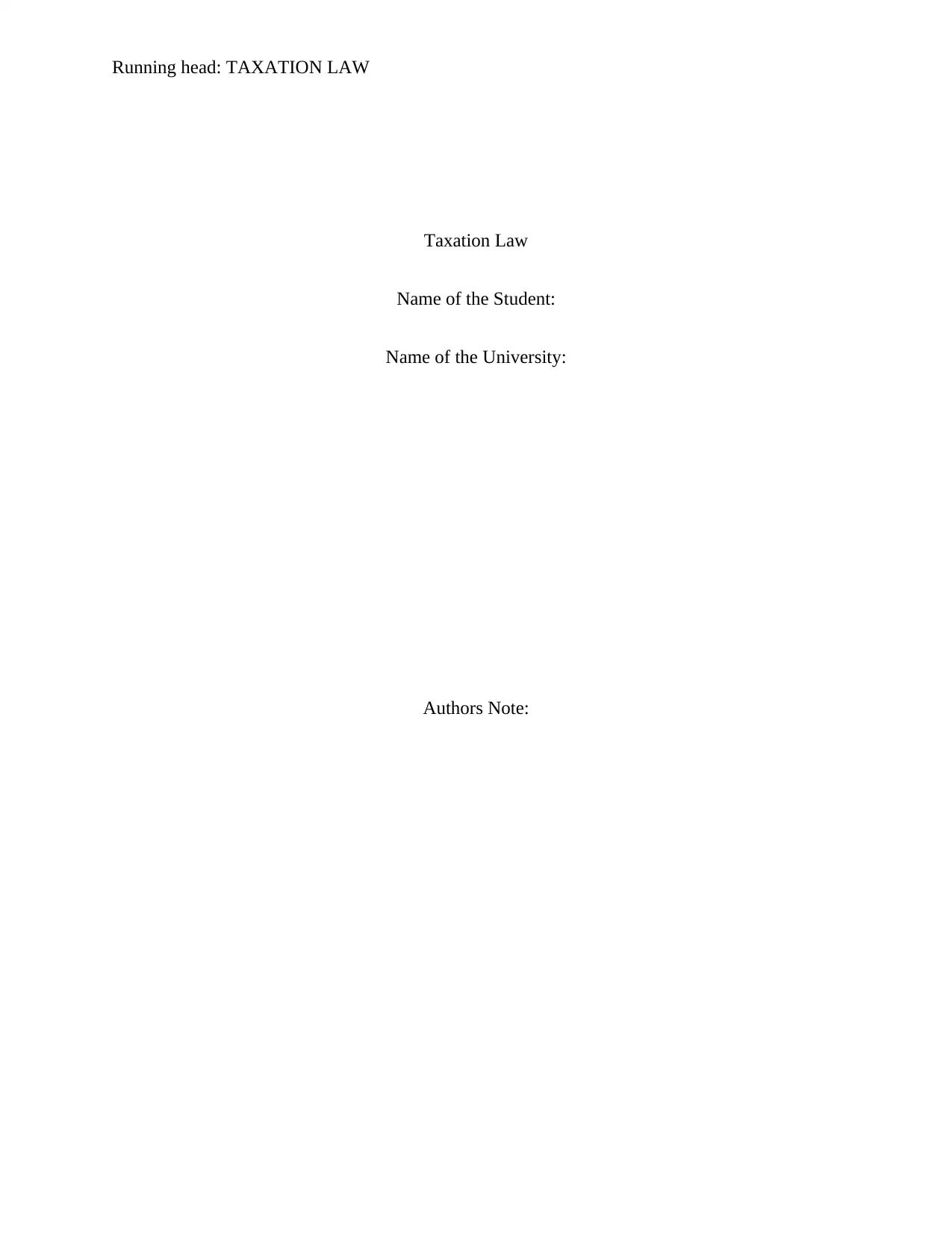
Running head: TAXATION LAW
Taxation Law
Name of the Student:
Name of the University:
Authors Note:
Taxation Law
Name of the Student:
Name of the University:
Authors Note:
Secure Best Marks with AI Grader
Need help grading? Try our AI Grader for instant feedback on your assignments.
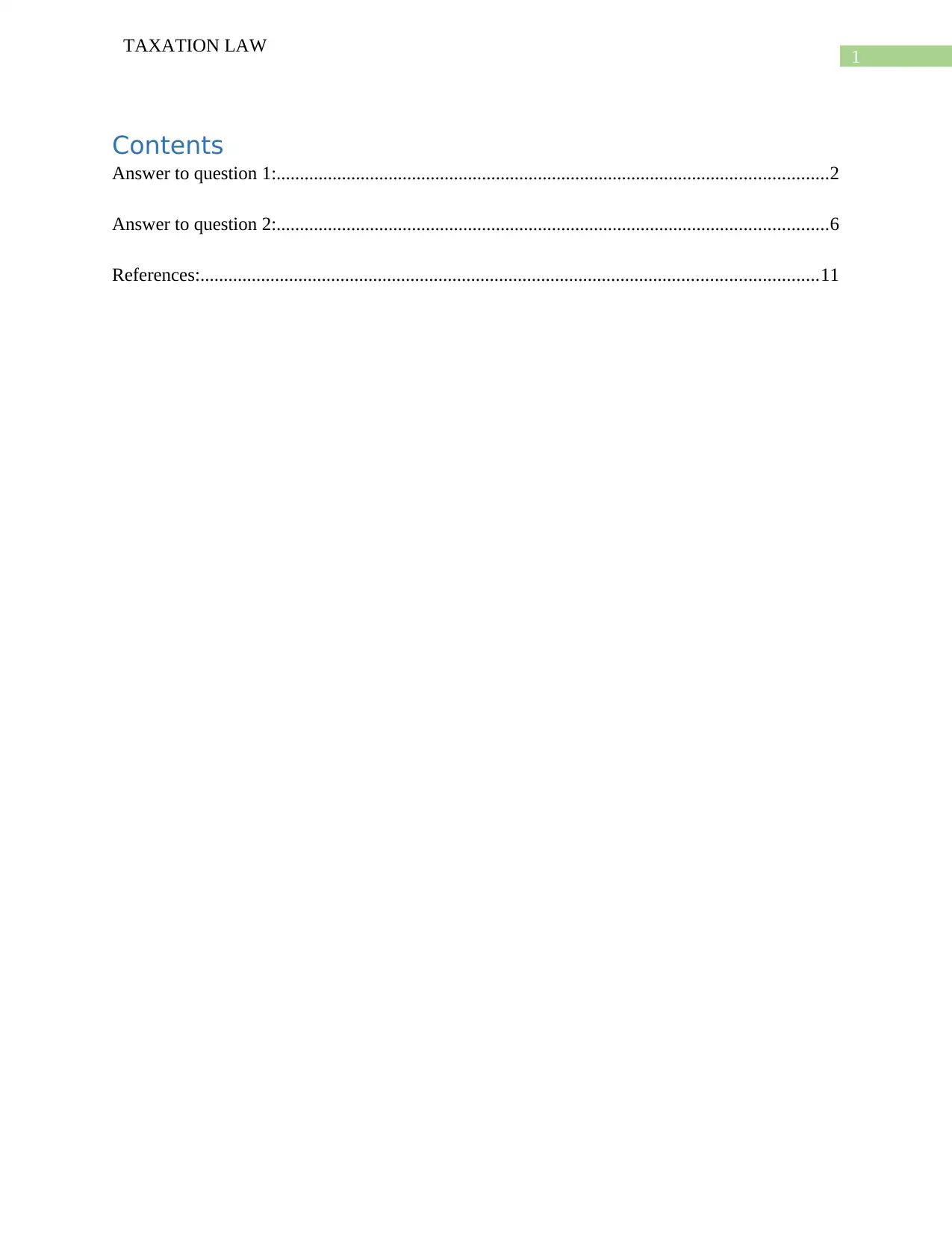
1
TAXATION LAW
Contents
Answer to question 1:......................................................................................................................2
Answer to question 2:......................................................................................................................6
References:....................................................................................................................................11
TAXATION LAW
Contents
Answer to question 1:......................................................................................................................2
Answer to question 2:......................................................................................................................6
References:....................................................................................................................................11
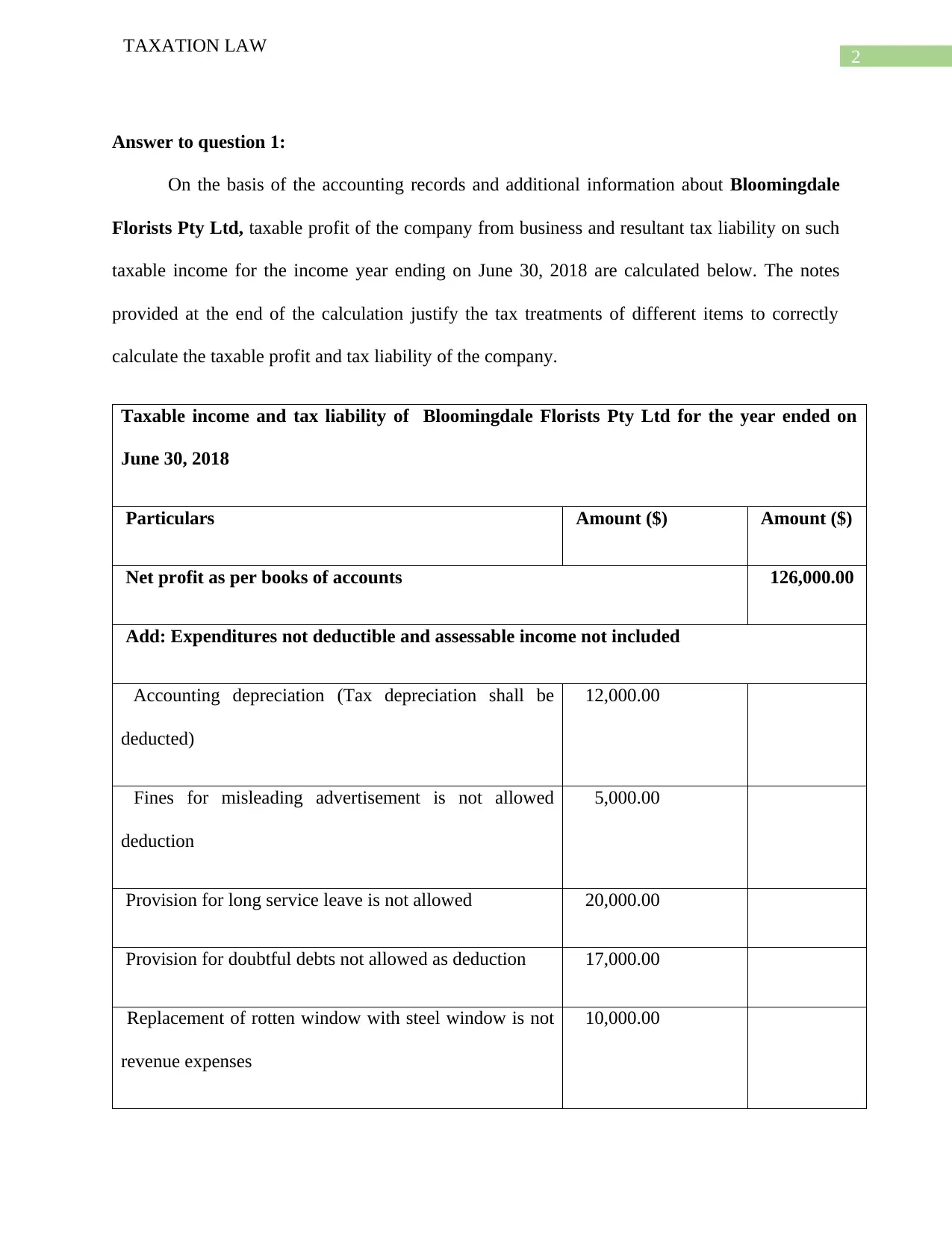
2
TAXATION LAW
Answer to question 1:
On the basis of the accounting records and additional information about Bloomingdale
Florists Pty Ltd, taxable profit of the company from business and resultant tax liability on such
taxable income for the income year ending on June 30, 2018 are calculated below. The notes
provided at the end of the calculation justify the tax treatments of different items to correctly
calculate the taxable profit and tax liability of the company.
Taxable income and tax liability of Bloomingdale Florists Pty Ltd for the year ended on
June 30, 2018
Particulars Amount ($) Amount ($)
Net profit as per books of accounts 126,000.00
Add: Expenditures not deductible and assessable income not included
Accounting depreciation (Tax depreciation shall be
deducted)
12,000.00
Fines for misleading advertisement is not allowed
deduction
5,000.00
Provision for long service leave is not allowed 20,000.00
Provision for doubtful debts not allowed as deduction 17,000.00
Replacement of rotten window with steel window is not
revenue expenses
10,000.00
TAXATION LAW
Answer to question 1:
On the basis of the accounting records and additional information about Bloomingdale
Florists Pty Ltd, taxable profit of the company from business and resultant tax liability on such
taxable income for the income year ending on June 30, 2018 are calculated below. The notes
provided at the end of the calculation justify the tax treatments of different items to correctly
calculate the taxable profit and tax liability of the company.
Taxable income and tax liability of Bloomingdale Florists Pty Ltd for the year ended on
June 30, 2018
Particulars Amount ($) Amount ($)
Net profit as per books of accounts 126,000.00
Add: Expenditures not deductible and assessable income not included
Accounting depreciation (Tax depreciation shall be
deducted)
12,000.00
Fines for misleading advertisement is not allowed
deduction
5,000.00
Provision for long service leave is not allowed 20,000.00
Provision for doubtful debts not allowed as deduction 17,000.00
Replacement of rotten window with steel window is not
revenue expenses
10,000.00
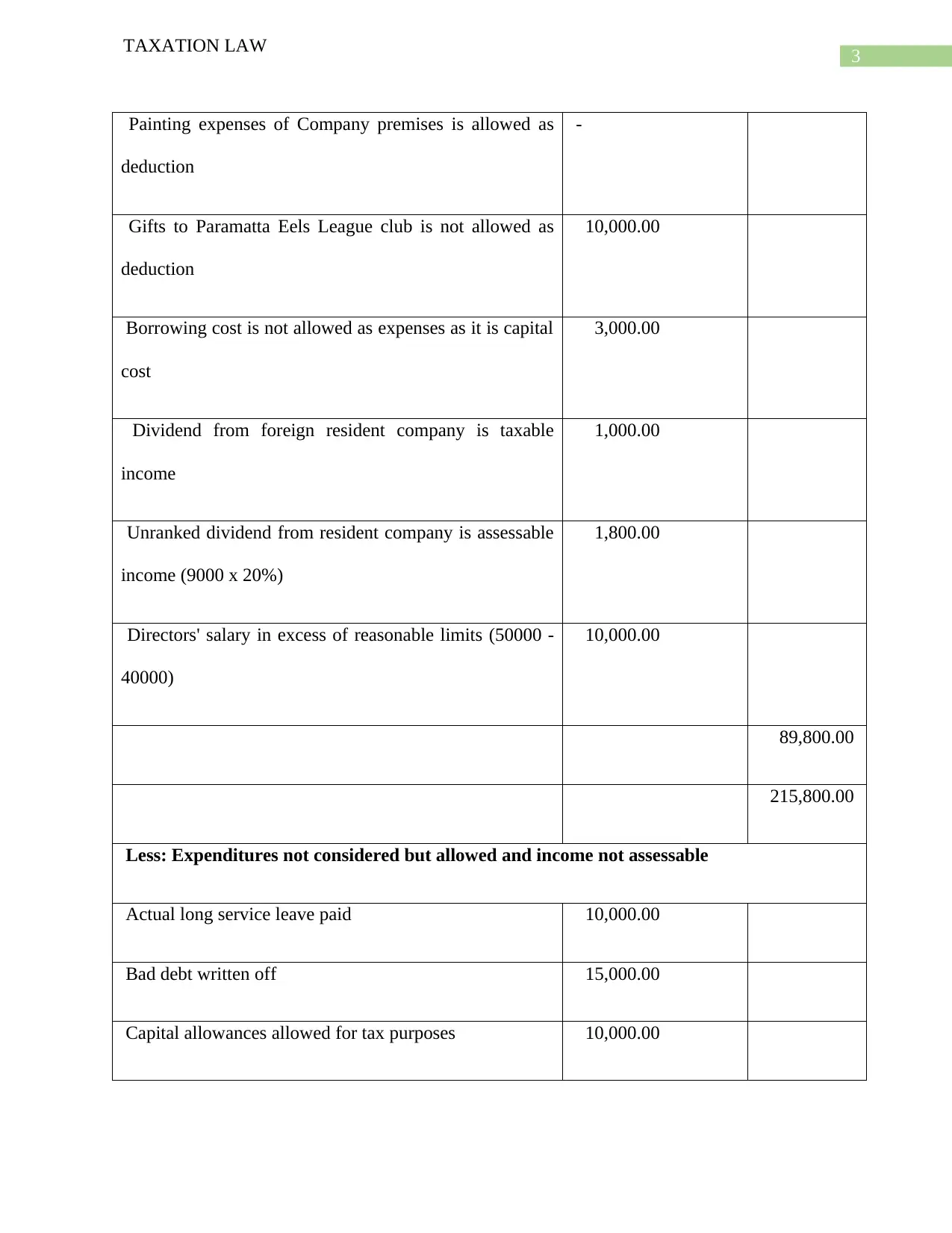
3
TAXATION LAW
Painting expenses of Company premises is allowed as
deduction
-
Gifts to Paramatta Eels League club is not allowed as
deduction
10,000.00
Borrowing cost is not allowed as expenses as it is capital
cost
3,000.00
Dividend from foreign resident company is taxable
income
1,000.00
Unranked dividend from resident company is assessable
income (9000 x 20%)
1,800.00
Directors' salary in excess of reasonable limits (50000 -
40000)
10,000.00
89,800.00
215,800.00
Less: Expenditures not considered but allowed and income not assessable
Actual long service leave paid 10,000.00
Bad debt written off 15,000.00
Capital allowances allowed for tax purposes 10,000.00
TAXATION LAW
Painting expenses of Company premises is allowed as
deduction
-
Gifts to Paramatta Eels League club is not allowed as
deduction
10,000.00
Borrowing cost is not allowed as expenses as it is capital
cost
3,000.00
Dividend from foreign resident company is taxable
income
1,000.00
Unranked dividend from resident company is assessable
income (9000 x 20%)
1,800.00
Directors' salary in excess of reasonable limits (50000 -
40000)
10,000.00
89,800.00
215,800.00
Less: Expenditures not considered but allowed and income not assessable
Actual long service leave paid 10,000.00
Bad debt written off 15,000.00
Capital allowances allowed for tax purposes 10,000.00
Secure Best Marks with AI Grader
Need help grading? Try our AI Grader for instant feedback on your assignments.
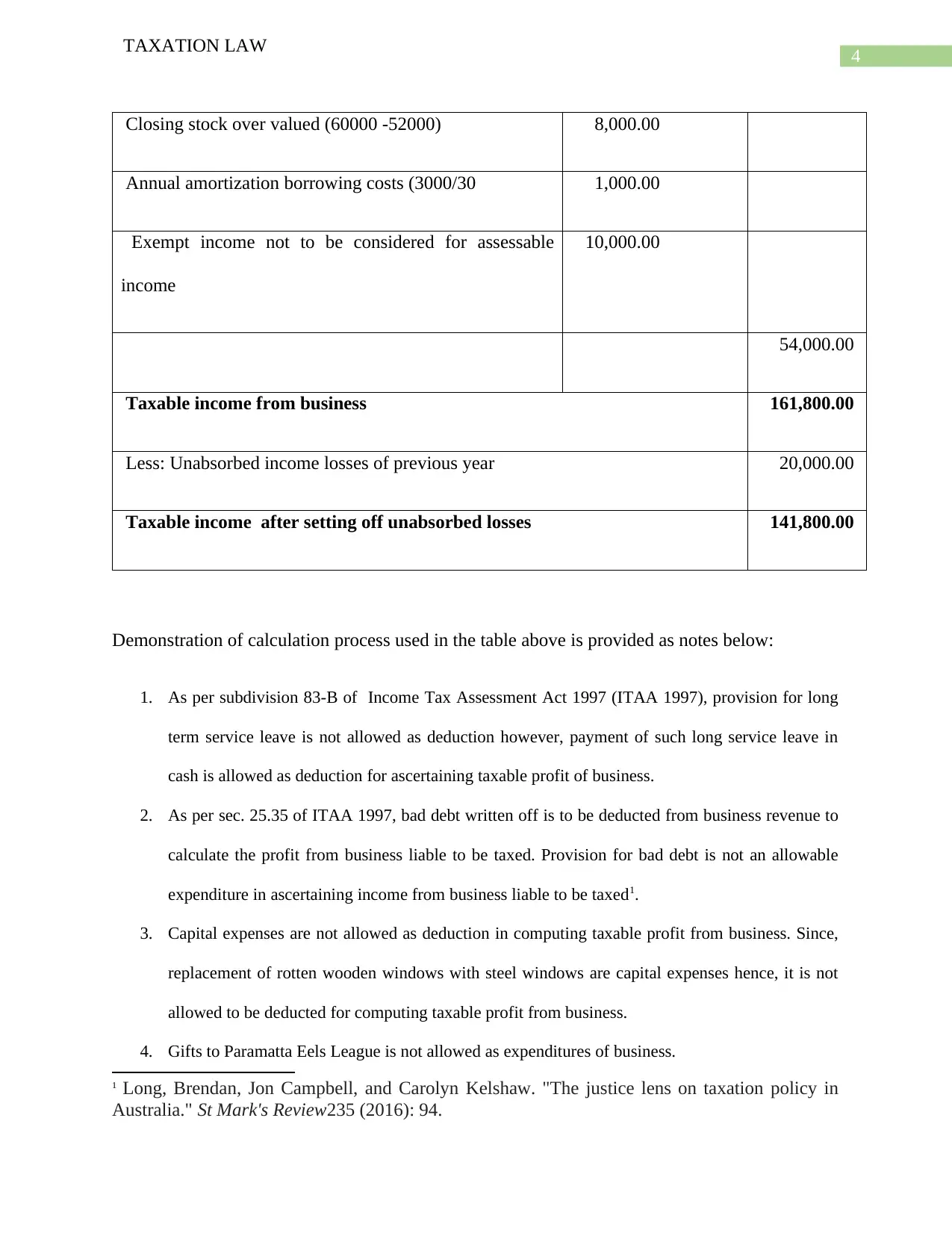
4
TAXATION LAW
Closing stock over valued (60000 -52000) 8,000.00
Annual amortization borrowing costs (3000/30 1,000.00
Exempt income not to be considered for assessable
income
10,000.00
54,000.00
Taxable income from business 161,800.00
Less: Unabsorbed income losses of previous year 20,000.00
Taxable income after setting off unabsorbed losses 141,800.00
Demonstration of calculation process used in the table above is provided as notes below:
1. As per subdivision 83-B of Income Tax Assessment Act 1997 (ITAA 1997), provision for long
term service leave is not allowed as deduction however, payment of such long service leave in
cash is allowed as deduction for ascertaining taxable profit of business.
2. As per sec. 25.35 of ITAA 1997, bad debt written off is to be deducted from business revenue to
calculate the profit from business liable to be taxed. Provision for bad debt is not an allowable
expenditure in ascertaining income from business liable to be taxed1.
3. Capital expenses are not allowed as deduction in computing taxable profit from business. Since,
replacement of rotten wooden windows with steel windows are capital expenses hence, it is not
allowed to be deducted for computing taxable profit from business.
4. Gifts to Paramatta Eels League is not allowed as expenditures of business.
1 Long, Brendan, Jon Campbell, and Carolyn Kelshaw. "The justice lens on taxation policy in
Australia." St Mark's Review235 (2016): 94.
TAXATION LAW
Closing stock over valued (60000 -52000) 8,000.00
Annual amortization borrowing costs (3000/30 1,000.00
Exempt income not to be considered for assessable
income
10,000.00
54,000.00
Taxable income from business 161,800.00
Less: Unabsorbed income losses of previous year 20,000.00
Taxable income after setting off unabsorbed losses 141,800.00
Demonstration of calculation process used in the table above is provided as notes below:
1. As per subdivision 83-B of Income Tax Assessment Act 1997 (ITAA 1997), provision for long
term service leave is not allowed as deduction however, payment of such long service leave in
cash is allowed as deduction for ascertaining taxable profit of business.
2. As per sec. 25.35 of ITAA 1997, bad debt written off is to be deducted from business revenue to
calculate the profit from business liable to be taxed. Provision for bad debt is not an allowable
expenditure in ascertaining income from business liable to be taxed1.
3. Capital expenses are not allowed as deduction in computing taxable profit from business. Since,
replacement of rotten wooden windows with steel windows are capital expenses hence, it is not
allowed to be deducted for computing taxable profit from business.
4. Gifts to Paramatta Eels League is not allowed as expenditures of business.
1 Long, Brendan, Jon Campbell, and Carolyn Kelshaw. "The justice lens on taxation policy in
Australia." St Mark's Review235 (2016): 94.
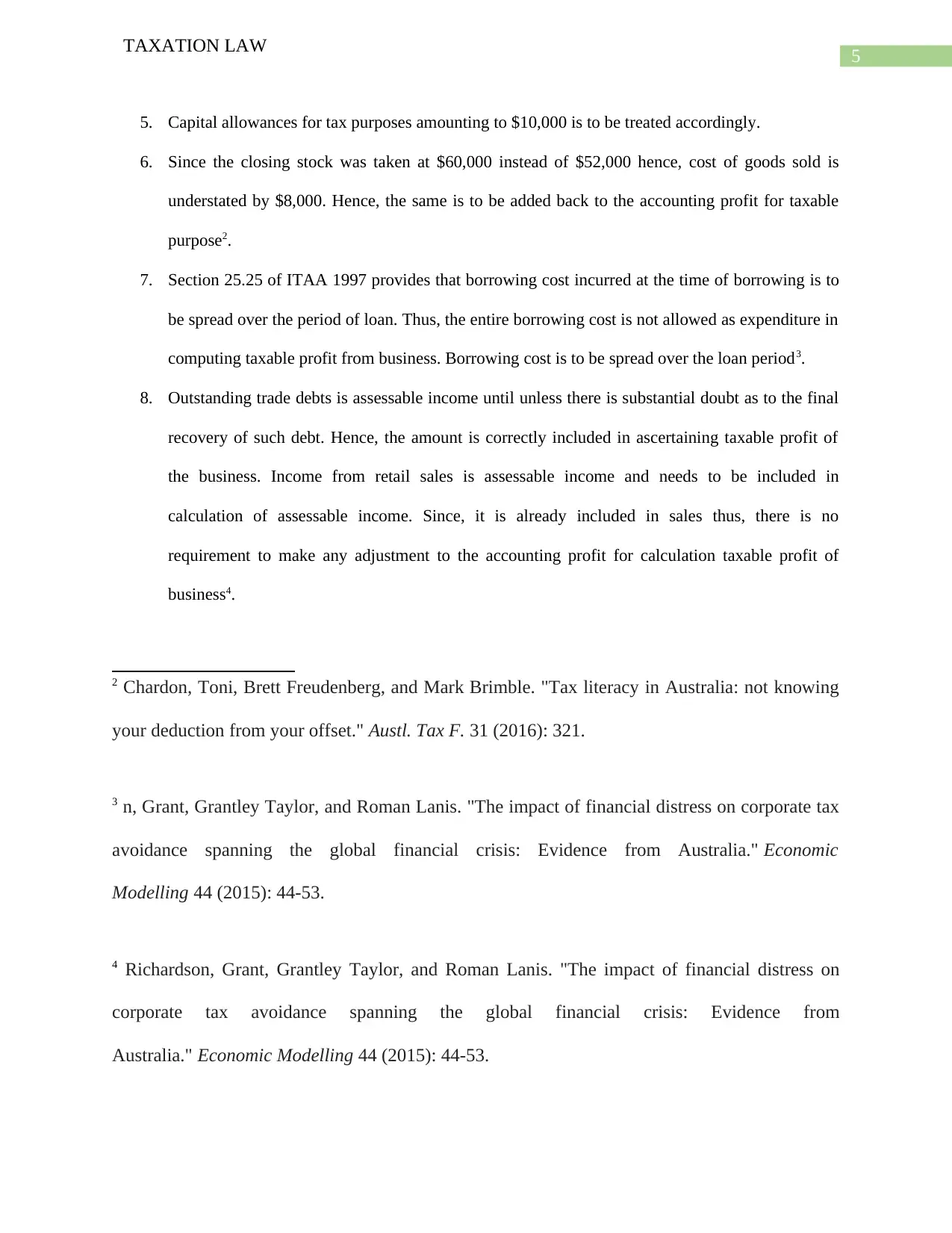
5
TAXATION LAW
5. Capital allowances for tax purposes amounting to $10,000 is to be treated accordingly.
6. Since the closing stock was taken at $60,000 instead of $52,000 hence, cost of goods sold is
understated by $8,000. Hence, the same is to be added back to the accounting profit for taxable
purpose2.
7. Section 25.25 of ITAA 1997 provides that borrowing cost incurred at the time of borrowing is to
be spread over the period of loan. Thus, the entire borrowing cost is not allowed as expenditure in
computing taxable profit from business. Borrowing cost is to be spread over the loan period3.
8. Outstanding trade debts is assessable income until unless there is substantial doubt as to the final
recovery of such debt. Hence, the amount is correctly included in ascertaining taxable profit of
the business. Income from retail sales is assessable income and needs to be included in
calculation of assessable income. Since, it is already included in sales thus, there is no
requirement to make any adjustment to the accounting profit for calculation taxable profit of
business4.
2 Chardon, Toni, Brett Freudenberg, and Mark Brimble. "Tax literacy in Australia: not knowing
your deduction from your offset." Austl. Tax F. 31 (2016): 321.
3 n, Grant, Grantley Taylor, and Roman Lanis. "The impact of financial distress on corporate tax
avoidance spanning the global financial crisis: Evidence from Australia." Economic
Modelling 44 (2015): 44-53.
4 Richardson, Grant, Grantley Taylor, and Roman Lanis. "The impact of financial distress on
corporate tax avoidance spanning the global financial crisis: Evidence from
Australia." Economic Modelling 44 (2015): 44-53.
TAXATION LAW
5. Capital allowances for tax purposes amounting to $10,000 is to be treated accordingly.
6. Since the closing stock was taken at $60,000 instead of $52,000 hence, cost of goods sold is
understated by $8,000. Hence, the same is to be added back to the accounting profit for taxable
purpose2.
7. Section 25.25 of ITAA 1997 provides that borrowing cost incurred at the time of borrowing is to
be spread over the period of loan. Thus, the entire borrowing cost is not allowed as expenditure in
computing taxable profit from business. Borrowing cost is to be spread over the loan period3.
8. Outstanding trade debts is assessable income until unless there is substantial doubt as to the final
recovery of such debt. Hence, the amount is correctly included in ascertaining taxable profit of
the business. Income from retail sales is assessable income and needs to be included in
calculation of assessable income. Since, it is already included in sales thus, there is no
requirement to make any adjustment to the accounting profit for calculation taxable profit of
business4.
2 Chardon, Toni, Brett Freudenberg, and Mark Brimble. "Tax literacy in Australia: not knowing
your deduction from your offset." Austl. Tax F. 31 (2016): 321.
3 n, Grant, Grantley Taylor, and Roman Lanis. "The impact of financial distress on corporate tax
avoidance spanning the global financial crisis: Evidence from Australia." Economic
Modelling 44 (2015): 44-53.
4 Richardson, Grant, Grantley Taylor, and Roman Lanis. "The impact of financial distress on
corporate tax avoidance spanning the global financial crisis: Evidence from
Australia." Economic Modelling 44 (2015): 44-53.
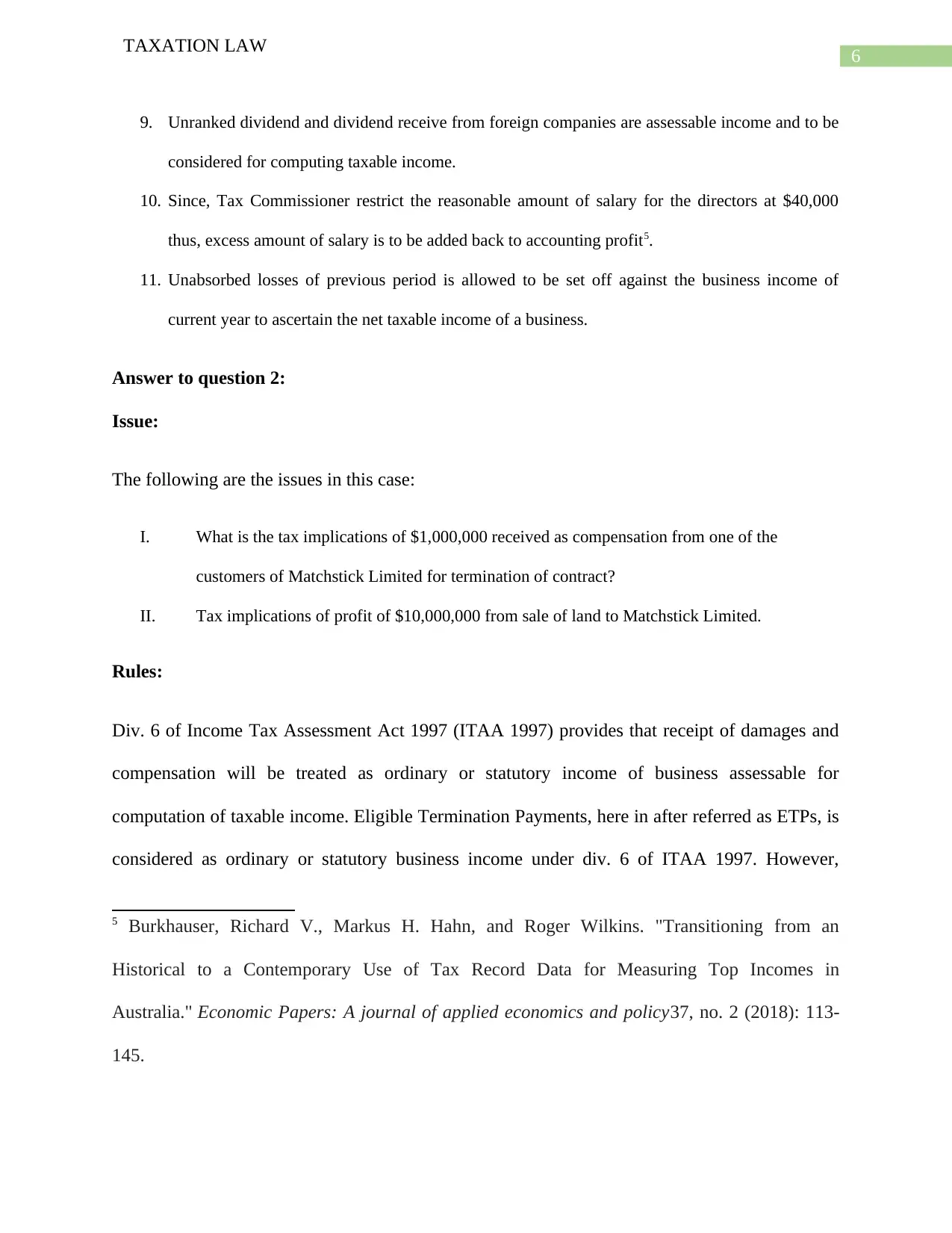
6
TAXATION LAW
9. Unranked dividend and dividend receive from foreign companies are assessable income and to be
considered for computing taxable income.
10. Since, Tax Commissioner restrict the reasonable amount of salary for the directors at $40,000
thus, excess amount of salary is to be added back to accounting profit5.
11. Unabsorbed losses of previous period is allowed to be set off against the business income of
current year to ascertain the net taxable income of a business.
Answer to question 2:
Issue:
The following are the issues in this case:
I. What is the tax implications of $1,000,000 received as compensation from one of the
customers of Matchstick Limited for termination of contract?
II. Tax implications of profit of $10,000,000 from sale of land to Matchstick Limited.
Rules:
Div. 6 of Income Tax Assessment Act 1997 (ITAA 1997) provides that receipt of damages and
compensation will be treated as ordinary or statutory income of business assessable for
computation of taxable income. Eligible Termination Payments, here in after referred as ETPs, is
considered as ordinary or statutory business income under div. 6 of ITAA 1997. However,
5 Burkhauser, Richard V., Markus H. Hahn, and Roger Wilkins. "Transitioning from an
Historical to a Contemporary Use of Tax Record Data for Measuring Top Incomes in
Australia." Economic Papers: A journal of applied economics and policy37, no. 2 (2018): 113-
145.
TAXATION LAW
9. Unranked dividend and dividend receive from foreign companies are assessable income and to be
considered for computing taxable income.
10. Since, Tax Commissioner restrict the reasonable amount of salary for the directors at $40,000
thus, excess amount of salary is to be added back to accounting profit5.
11. Unabsorbed losses of previous period is allowed to be set off against the business income of
current year to ascertain the net taxable income of a business.
Answer to question 2:
Issue:
The following are the issues in this case:
I. What is the tax implications of $1,000,000 received as compensation from one of the
customers of Matchstick Limited for termination of contract?
II. Tax implications of profit of $10,000,000 from sale of land to Matchstick Limited.
Rules:
Div. 6 of Income Tax Assessment Act 1997 (ITAA 1997) provides that receipt of damages and
compensation will be treated as ordinary or statutory income of business assessable for
computation of taxable income. Eligible Termination Payments, here in after referred as ETPs, is
considered as ordinary or statutory business income under div. 6 of ITAA 1997. However,
5 Burkhauser, Richard V., Markus H. Hahn, and Roger Wilkins. "Transitioning from an
Historical to a Contemporary Use of Tax Record Data for Measuring Top Incomes in
Australia." Economic Papers: A journal of applied economics and policy37, no. 2 (2018): 113-
145.
Paraphrase This Document
Need a fresh take? Get an instant paraphrase of this document with our AI Paraphraser
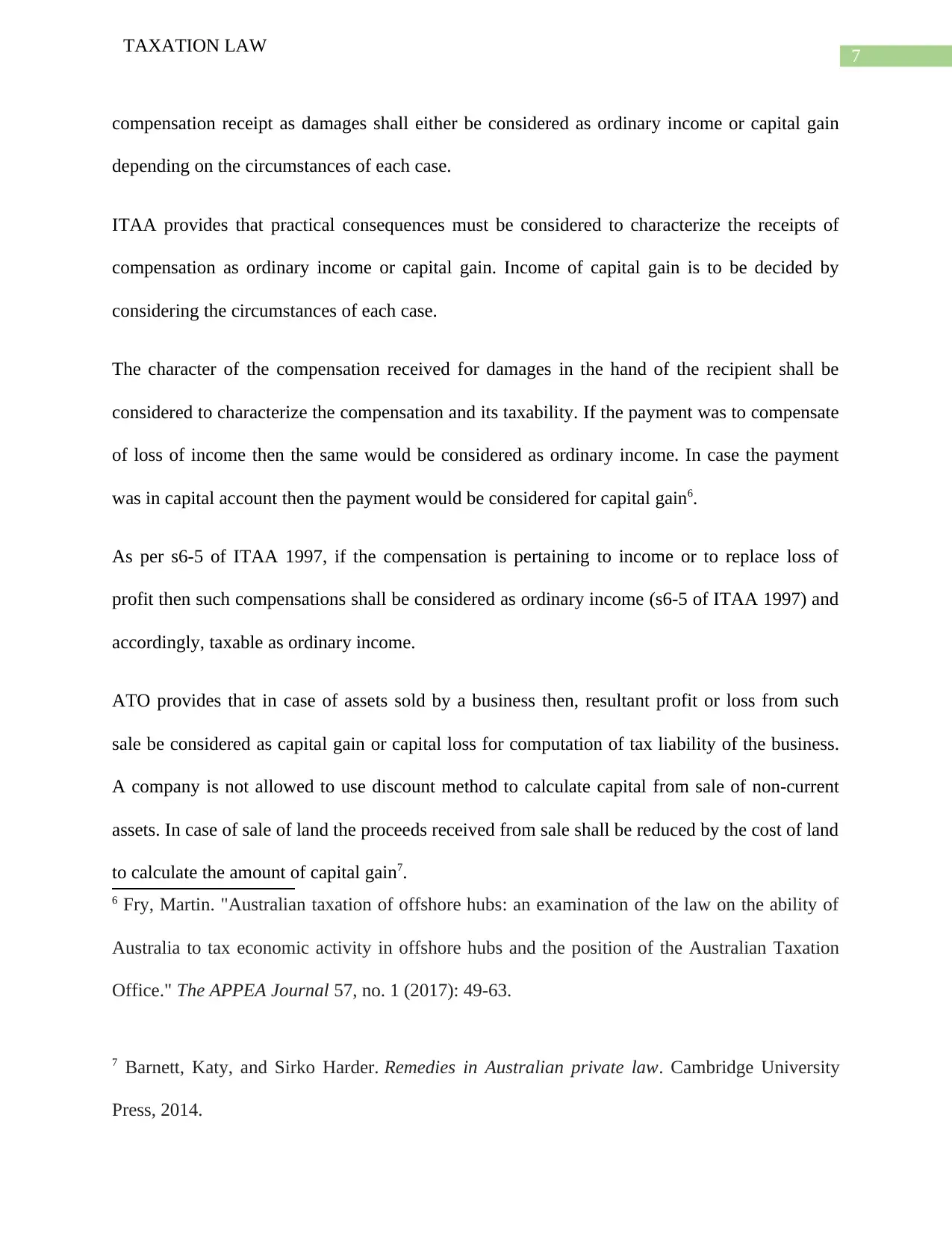
7
TAXATION LAW
compensation receipt as damages shall either be considered as ordinary income or capital gain
depending on the circumstances of each case.
ITAA provides that practical consequences must be considered to characterize the receipts of
compensation as ordinary income or capital gain. Income of capital gain is to be decided by
considering the circumstances of each case.
The character of the compensation received for damages in the hand of the recipient shall be
considered to characterize the compensation and its taxability. If the payment was to compensate
of loss of income then the same would be considered as ordinary income. In case the payment
was in capital account then the payment would be considered for capital gain6.
As per s6-5 of ITAA 1997, if the compensation is pertaining to income or to replace loss of
profit then such compensations shall be considered as ordinary income (s6-5 of ITAA 1997) and
accordingly, taxable as ordinary income.
ATO provides that in case of assets sold by a business then, resultant profit or loss from such
sale be considered as capital gain or capital loss for computation of tax liability of the business.
A company is not allowed to use discount method to calculate capital from sale of non-current
assets. In case of sale of land the proceeds received from sale shall be reduced by the cost of land
to calculate the amount of capital gain7.
6 Fry, Martin. "Australian taxation of offshore hubs: an examination of the law on the ability of
Australia to tax economic activity in offshore hubs and the position of the Australian Taxation
Office." The APPEA Journal 57, no. 1 (2017): 49-63.
7 Barnett, Katy, and Sirko Harder. Remedies in Australian private law. Cambridge University
Press, 2014.
TAXATION LAW
compensation receipt as damages shall either be considered as ordinary income or capital gain
depending on the circumstances of each case.
ITAA provides that practical consequences must be considered to characterize the receipts of
compensation as ordinary income or capital gain. Income of capital gain is to be decided by
considering the circumstances of each case.
The character of the compensation received for damages in the hand of the recipient shall be
considered to characterize the compensation and its taxability. If the payment was to compensate
of loss of income then the same would be considered as ordinary income. In case the payment
was in capital account then the payment would be considered for capital gain6.
As per s6-5 of ITAA 1997, if the compensation is pertaining to income or to replace loss of
profit then such compensations shall be considered as ordinary income (s6-5 of ITAA 1997) and
accordingly, taxable as ordinary income.
ATO provides that in case of assets sold by a business then, resultant profit or loss from such
sale be considered as capital gain or capital loss for computation of tax liability of the business.
A company is not allowed to use discount method to calculate capital from sale of non-current
assets. In case of sale of land the proceeds received from sale shall be reduced by the cost of land
to calculate the amount of capital gain7.
6 Fry, Martin. "Australian taxation of offshore hubs: an examination of the law on the ability of
Australia to tax economic activity in offshore hubs and the position of the Australian Taxation
Office." The APPEA Journal 57, no. 1 (2017): 49-63.
7 Barnett, Katy, and Sirko Harder. Remedies in Australian private law. Cambridge University
Press, 2014.
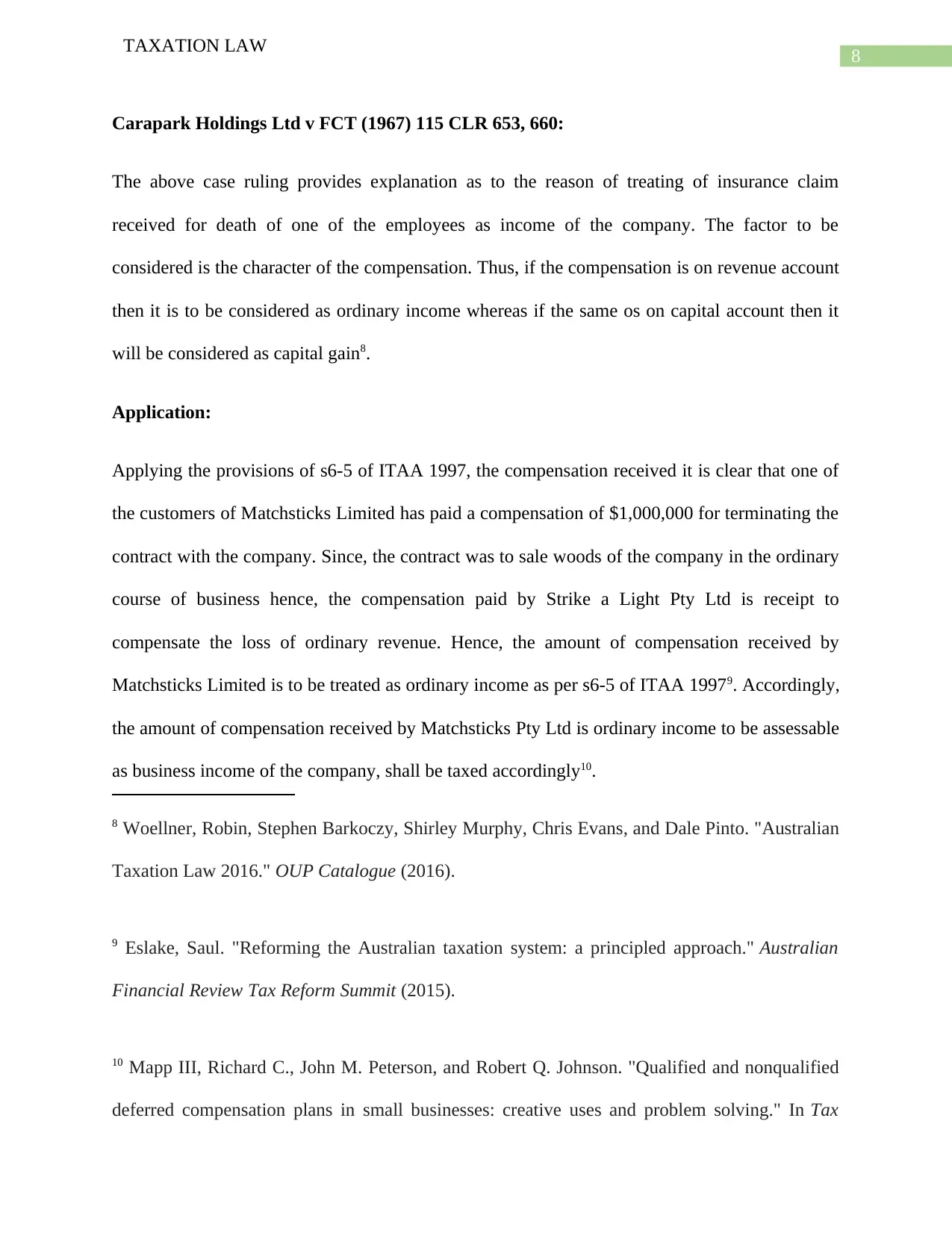
8
TAXATION LAW
Carapark Holdings Ltd v FCT (1967) 115 CLR 653, 660:
The above case ruling provides explanation as to the reason of treating of insurance claim
received for death of one of the employees as income of the company. The factor to be
considered is the character of the compensation. Thus, if the compensation is on revenue account
then it is to be considered as ordinary income whereas if the same os on capital account then it
will be considered as capital gain8.
Application:
Applying the provisions of s6-5 of ITAA 1997, the compensation received it is clear that one of
the customers of Matchsticks Limited has paid a compensation of $1,000,000 for terminating the
contract with the company. Since, the contract was to sale woods of the company in the ordinary
course of business hence, the compensation paid by Strike a Light Pty Ltd is receipt to
compensate the loss of ordinary revenue. Hence, the amount of compensation received by
Matchsticks Limited is to be treated as ordinary income as per s6-5 of ITAA 19979. Accordingly,
the amount of compensation received by Matchsticks Pty Ltd is ordinary income to be assessable
as business income of the company, shall be taxed accordingly10.
8 Woellner, Robin, Stephen Barkoczy, Shirley Murphy, Chris Evans, and Dale Pinto. "Australian
Taxation Law 2016." OUP Catalogue (2016).
9 Eslake, Saul. "Reforming the Australian taxation system: a principled approach." Australian
Financial Review Tax Reform Summit (2015).
10 Mapp III, Richard C., John M. Peterson, and Robert Q. Johnson. "Qualified and nonqualified
deferred compensation plans in small businesses: creative uses and problem solving." In Tax
TAXATION LAW
Carapark Holdings Ltd v FCT (1967) 115 CLR 653, 660:
The above case ruling provides explanation as to the reason of treating of insurance claim
received for death of one of the employees as income of the company. The factor to be
considered is the character of the compensation. Thus, if the compensation is on revenue account
then it is to be considered as ordinary income whereas if the same os on capital account then it
will be considered as capital gain8.
Application:
Applying the provisions of s6-5 of ITAA 1997, the compensation received it is clear that one of
the customers of Matchsticks Limited has paid a compensation of $1,000,000 for terminating the
contract with the company. Since, the contract was to sale woods of the company in the ordinary
course of business hence, the compensation paid by Strike a Light Pty Ltd is receipt to
compensate the loss of ordinary revenue. Hence, the amount of compensation received by
Matchsticks Limited is to be treated as ordinary income as per s6-5 of ITAA 19979. Accordingly,
the amount of compensation received by Matchsticks Pty Ltd is ordinary income to be assessable
as business income of the company, shall be taxed accordingly10.
8 Woellner, Robin, Stephen Barkoczy, Shirley Murphy, Chris Evans, and Dale Pinto. "Australian
Taxation Law 2016." OUP Catalogue (2016).
9 Eslake, Saul. "Reforming the Australian taxation system: a principled approach." Australian
Financial Review Tax Reform Summit (2015).
10 Mapp III, Richard C., John M. Peterson, and Robert Q. Johnson. "Qualified and nonqualified
deferred compensation plans in small businesses: creative uses and problem solving." In Tax
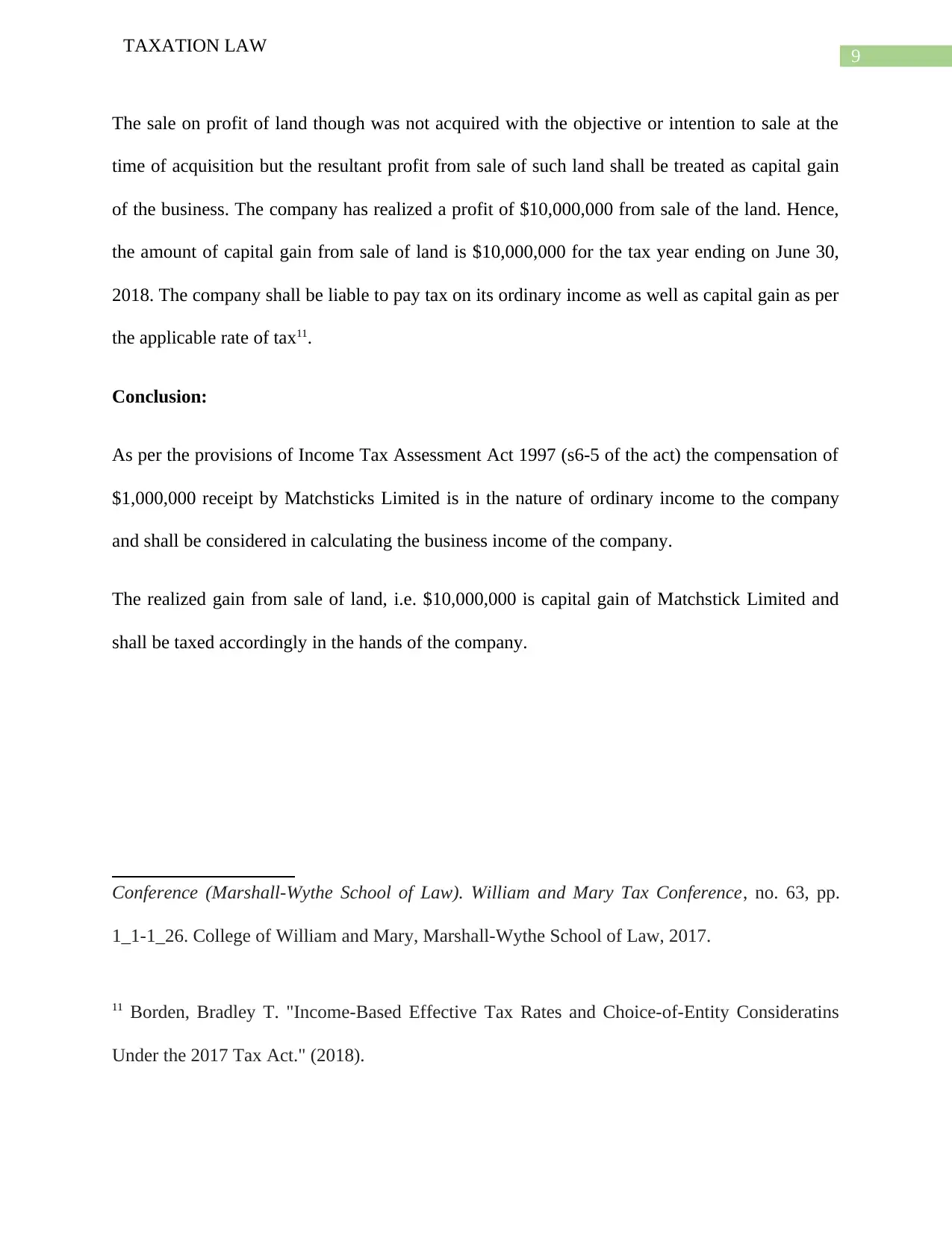
9
TAXATION LAW
The sale on profit of land though was not acquired with the objective or intention to sale at the
time of acquisition but the resultant profit from sale of such land shall be treated as capital gain
of the business. The company has realized a profit of $10,000,000 from sale of the land. Hence,
the amount of capital gain from sale of land is $10,000,000 for the tax year ending on June 30,
2018. The company shall be liable to pay tax on its ordinary income as well as capital gain as per
the applicable rate of tax11.
Conclusion:
As per the provisions of Income Tax Assessment Act 1997 (s6-5 of the act) the compensation of
$1,000,000 receipt by Matchsticks Limited is in the nature of ordinary income to the company
and shall be considered in calculating the business income of the company.
The realized gain from sale of land, i.e. $10,000,000 is capital gain of Matchstick Limited and
shall be taxed accordingly in the hands of the company.
Conference (Marshall-Wythe School of Law). William and Mary Tax Conference, no. 63, pp.
1_1-1_26. College of William and Mary, Marshall-Wythe School of Law, 2017.
11 Borden, Bradley T. "Income-Based Effective Tax Rates and Choice-of-Entity Consideratins
Under the 2017 Tax Act." (2018).
TAXATION LAW
The sale on profit of land though was not acquired with the objective or intention to sale at the
time of acquisition but the resultant profit from sale of such land shall be treated as capital gain
of the business. The company has realized a profit of $10,000,000 from sale of the land. Hence,
the amount of capital gain from sale of land is $10,000,000 for the tax year ending on June 30,
2018. The company shall be liable to pay tax on its ordinary income as well as capital gain as per
the applicable rate of tax11.
Conclusion:
As per the provisions of Income Tax Assessment Act 1997 (s6-5 of the act) the compensation of
$1,000,000 receipt by Matchsticks Limited is in the nature of ordinary income to the company
and shall be considered in calculating the business income of the company.
The realized gain from sale of land, i.e. $10,000,000 is capital gain of Matchstick Limited and
shall be taxed accordingly in the hands of the company.
Conference (Marshall-Wythe School of Law). William and Mary Tax Conference, no. 63, pp.
1_1-1_26. College of William and Mary, Marshall-Wythe School of Law, 2017.
11 Borden, Bradley T. "Income-Based Effective Tax Rates and Choice-of-Entity Consideratins
Under the 2017 Tax Act." (2018).
Secure Best Marks with AI Grader
Need help grading? Try our AI Grader for instant feedback on your assignments.
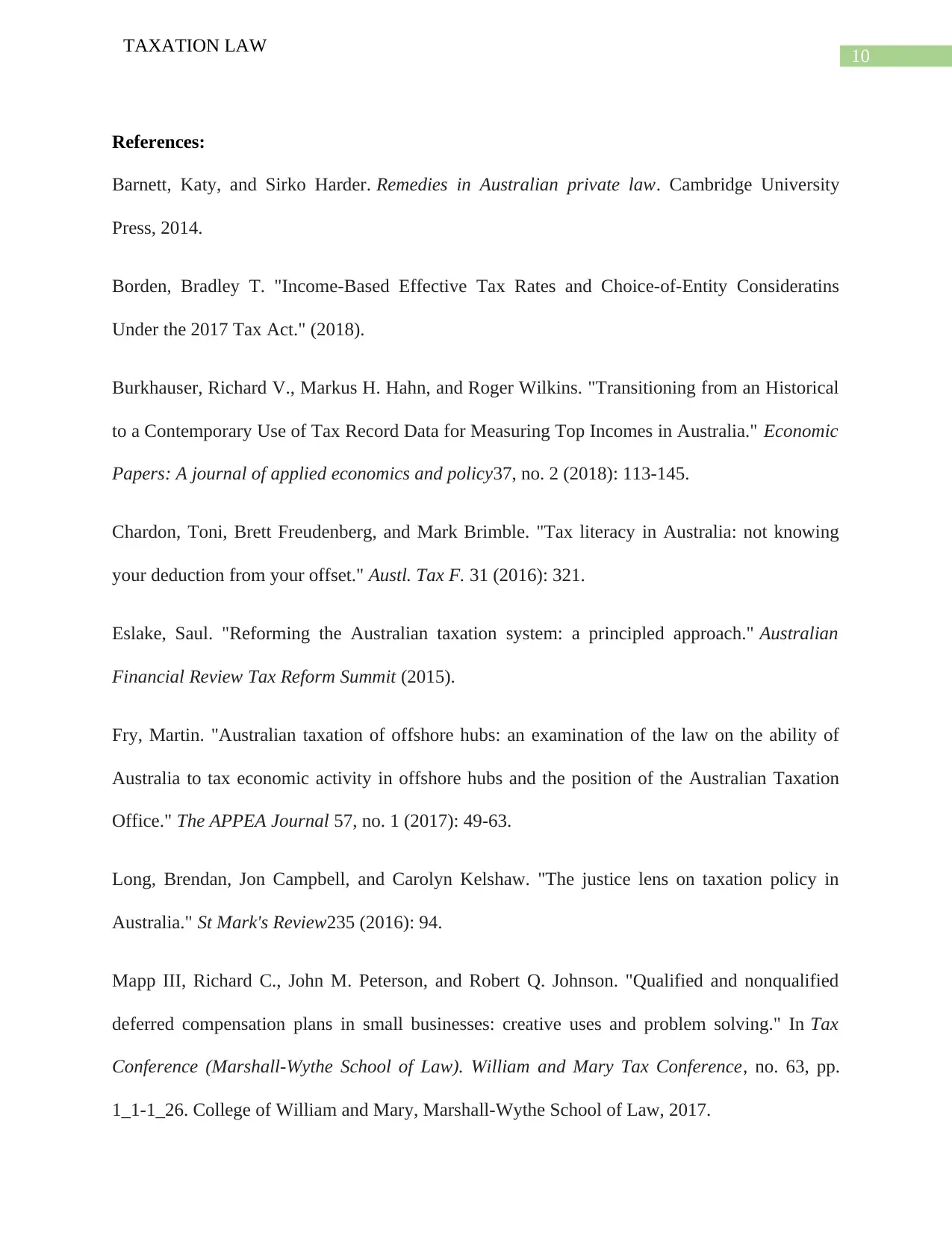
10
TAXATION LAW
References:
Barnett, Katy, and Sirko Harder. Remedies in Australian private law. Cambridge University
Press, 2014.
Borden, Bradley T. "Income-Based Effective Tax Rates and Choice-of-Entity Consideratins
Under the 2017 Tax Act." (2018).
Burkhauser, Richard V., Markus H. Hahn, and Roger Wilkins. "Transitioning from an Historical
to a Contemporary Use of Tax Record Data for Measuring Top Incomes in Australia." Economic
Papers: A journal of applied economics and policy37, no. 2 (2018): 113-145.
Chardon, Toni, Brett Freudenberg, and Mark Brimble. "Tax literacy in Australia: not knowing
your deduction from your offset." Austl. Tax F. 31 (2016): 321.
Eslake, Saul. "Reforming the Australian taxation system: a principled approach." Australian
Financial Review Tax Reform Summit (2015).
Fry, Martin. "Australian taxation of offshore hubs: an examination of the law on the ability of
Australia to tax economic activity in offshore hubs and the position of the Australian Taxation
Office." The APPEA Journal 57, no. 1 (2017): 49-63.
Long, Brendan, Jon Campbell, and Carolyn Kelshaw. "The justice lens on taxation policy in
Australia." St Mark's Review235 (2016): 94.
Mapp III, Richard C., John M. Peterson, and Robert Q. Johnson. "Qualified and nonqualified
deferred compensation plans in small businesses: creative uses and problem solving." In Tax
Conference (Marshall-Wythe School of Law). William and Mary Tax Conference, no. 63, pp.
1_1-1_26. College of William and Mary, Marshall-Wythe School of Law, 2017.
TAXATION LAW
References:
Barnett, Katy, and Sirko Harder. Remedies in Australian private law. Cambridge University
Press, 2014.
Borden, Bradley T. "Income-Based Effective Tax Rates and Choice-of-Entity Consideratins
Under the 2017 Tax Act." (2018).
Burkhauser, Richard V., Markus H. Hahn, and Roger Wilkins. "Transitioning from an Historical
to a Contemporary Use of Tax Record Data for Measuring Top Incomes in Australia." Economic
Papers: A journal of applied economics and policy37, no. 2 (2018): 113-145.
Chardon, Toni, Brett Freudenberg, and Mark Brimble. "Tax literacy in Australia: not knowing
your deduction from your offset." Austl. Tax F. 31 (2016): 321.
Eslake, Saul. "Reforming the Australian taxation system: a principled approach." Australian
Financial Review Tax Reform Summit (2015).
Fry, Martin. "Australian taxation of offshore hubs: an examination of the law on the ability of
Australia to tax economic activity in offshore hubs and the position of the Australian Taxation
Office." The APPEA Journal 57, no. 1 (2017): 49-63.
Long, Brendan, Jon Campbell, and Carolyn Kelshaw. "The justice lens on taxation policy in
Australia." St Mark's Review235 (2016): 94.
Mapp III, Richard C., John M. Peterson, and Robert Q. Johnson. "Qualified and nonqualified
deferred compensation plans in small businesses: creative uses and problem solving." In Tax
Conference (Marshall-Wythe School of Law). William and Mary Tax Conference, no. 63, pp.
1_1-1_26. College of William and Mary, Marshall-Wythe School of Law, 2017.
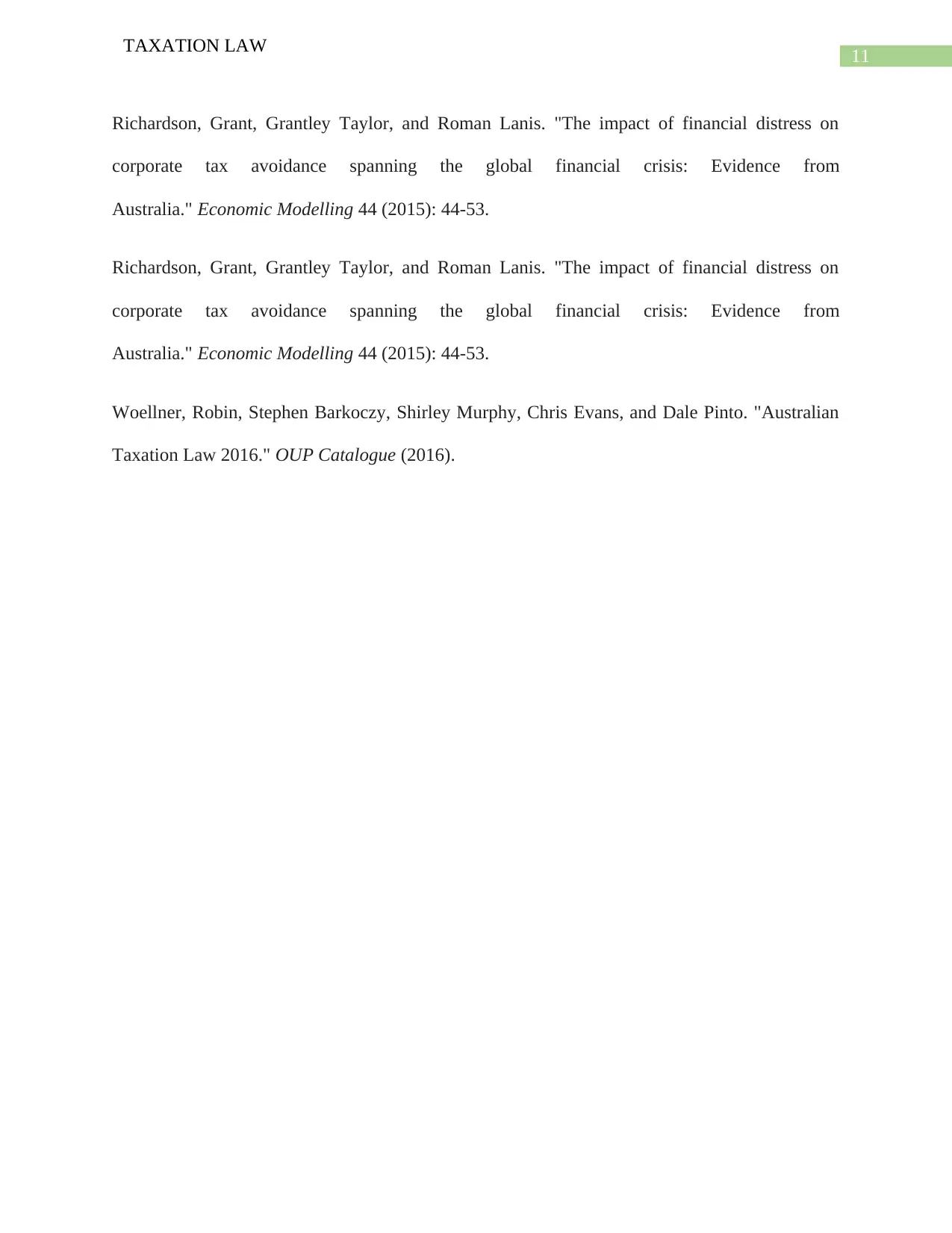
11
TAXATION LAW
Richardson, Grant, Grantley Taylor, and Roman Lanis. "The impact of financial distress on
corporate tax avoidance spanning the global financial crisis: Evidence from
Australia." Economic Modelling 44 (2015): 44-53.
Richardson, Grant, Grantley Taylor, and Roman Lanis. "The impact of financial distress on
corporate tax avoidance spanning the global financial crisis: Evidence from
Australia." Economic Modelling 44 (2015): 44-53.
Woellner, Robin, Stephen Barkoczy, Shirley Murphy, Chris Evans, and Dale Pinto. "Australian
Taxation Law 2016." OUP Catalogue (2016).
TAXATION LAW
Richardson, Grant, Grantley Taylor, and Roman Lanis. "The impact of financial distress on
corporate tax avoidance spanning the global financial crisis: Evidence from
Australia." Economic Modelling 44 (2015): 44-53.
Richardson, Grant, Grantley Taylor, and Roman Lanis. "The impact of financial distress on
corporate tax avoidance spanning the global financial crisis: Evidence from
Australia." Economic Modelling 44 (2015): 44-53.
Woellner, Robin, Stephen Barkoczy, Shirley Murphy, Chris Evans, and Dale Pinto. "Australian
Taxation Law 2016." OUP Catalogue (2016).
1 out of 12
Related Documents
Your All-in-One AI-Powered Toolkit for Academic Success.
+13062052269
info@desklib.com
Available 24*7 on WhatsApp / Email
![[object Object]](/_next/static/media/star-bottom.7253800d.svg)
Unlock your academic potential
© 2024 | Zucol Services PVT LTD | All rights reserved.




